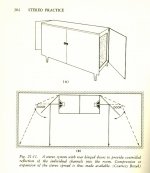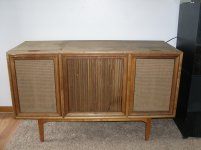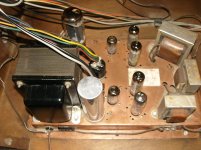Here is my version of the single stereo system. Three four inch mids with Piezos in a separate chamber with a sealed ten inch DVC with the crossover at 400HZ. OK, the color is strange but I had the paint left over and what else to you do with MDF?
It needs a narrow room ten feet of less to give stereo, however place it in a corner and you get some good imaging and of course more bass than you need.
The Piezos are attenuated 6dB to match the mids and the center channel is down 3dB. An interesting experiment that saves you some wood and work but it was tried in fifties and sixties but never caught on.
Looks good
You are right the room width should be in correct proportion to the listening distance. In practise narrow rooms are better for this concept. Shoebox room is ideal.
Did you implement any psychoacoustic filter ?
That is interesting you mention early trials of this concept in 50's / 60's, can you tell more specificly who what when ?
- Elias
Derived third channels were used by a number of manufacturers in the early day of stereo.
Here are a few references;
Tremain, Howard, The Audio Cyclopedia-Howards W. Sams, 1969-Page 1138. Paragraph 20.154 Method For Deriving a Third Channel.
Cohen, Abraham-Hi Fi Lousdpeakers and Enclosures, Hayden Books, 1968-Chapter 27, Electrical Third Channel
Klipsch, Paul-Volume II Audio Amateur Publications-Audiocraft Magazine,
January 1958, Page 37, Simplified Phantom Third Channel
However, your approach is unique with the high steering circuit. I did not see a great deal of difference in trying the steering circuit but I will continue to do some additional experimentation with it.
Here are a few references;
Tremain, Howard, The Audio Cyclopedia-Howards W. Sams, 1969-Page 1138. Paragraph 20.154 Method For Deriving a Third Channel.
Cohen, Abraham-Hi Fi Lousdpeakers and Enclosures, Hayden Books, 1968-Chapter 27, Electrical Third Channel
Klipsch, Paul-Volume II Audio Amateur Publications-Audiocraft Magazine,
January 1958, Page 37, Simplified Phantom Third Channel
However, your approach is unique with the high steering circuit. I did not see a great deal of difference in trying the steering circuit but I will continue to do some additional experimentation with it.
Derived third channels were used by a number of manufacturers in the early day of stereo.
Here are a few references;
Tremain, Howard, The Audio Cyclopedia-Howards W. Sams, 1969-Page 1138. Paragraph 20.154 Method For Deriving a Third Channel.
Cohen, Abraham-Hi Fi Lousdpeakers and Enclosures, Hayden Books, 1968-Chapter 27, Electrical Third Channel
Klipsch, Paul-Volume II Audio Amateur Publications-Audiocraft Magazine,
January 1958, Page 37, Simplified Phantom Third Channel
However, your approach is unique with the high steering circuit. I did not see a great deal of difference in trying the steering circuit but I will continue to do some additional experimentation with it.
Thanks for those references. I didn't find any of them with google though
Yes three loudspeakers have been experimentally used for 2 channel stereo reproduction since the early days of radio. But I havent seen similar matrixed speaker integrated in one small box. I know there are MS stereo speakers done before, but they use different matrix than x=0.5.
So, I thought I'll integrate room side wall reflections into the equation and voilá single speaker stereo was born
About the filter, as the effect depends on the room geometry and wall absorption and listening preference, it may take a while to find the optimum.
- Elias
Yes Elia those are vintage references but at age 73, I am also vintage. Attached is a vintage idea that I may try for larger rooms. Hinged reflectors mounted on the cabinet rear so they can be adjusted to control the spread. This was used in a Bozak system and Electro Voice also had a version. I write for Audio Express Magazine and am thinking of writing an article on my version of your system for publication in the fall. If so, I will certainly give you full credit for the concept. Let me know if you would approve of same.
Attachments
Yes Elia those are vintage references but at age 73, I am also vintage. Attached is a vintage idea that I may try for larger rooms. Hinged reflectors mounted on the cabinet rear so they can be adjusted to control the spread. This was used in a Bozak system and Electro Voice also had a version. I write for Audio Express Magazine and am thinking of writing an article on my version of your system for publication in the fall. If so, I will certainly give you full credit for the concept. Let me know if you would approve of same.
There was some disscussion here at diyaudio about Bozak including the one with hinged doors. It is inspiring to see the early experimenters had fresh ideas at their time, now being forgotten long ago.
I have no problem you writing to Audio Express about your build. Hopefully it gets published
Good listening and 73s, as hams use to say
- Elias
My '59 Motorola SK32W console is three channel. The center channel is derived before the amp.
Any idea of the matrix coefficients, or how the wiring is done ?
Ha. I'm reminded of the line from LOTR:Thanks for those references. I didn't find any of them with google thoughThey may be too vintage for modern information highway.
"Much that once was, is lost, for none now live who remember it"
Well obviously a few of us still live, but I find precious little "new" (about loudspeakers) that you won't find in the pages of "Audio" magazine from the 1960's . . .
Can someone please explain how you go about hooking up a three-driver single stereo speaker to a two-channel power amp?
I have had a look at Elias' paper on 'Stereophonic Sound from a Single Speaker' and kind of get the gist of the circuit diagram on p5 but don't understand the "Common" term at the bottom.
I have a trio of Visaton B200s I'd like to use to assess this interesting alternative to stereo sound.
Why try this? Two reasons. I like the possibilities of imaging across a wide area - I already get that in part with waveguides - but also I really like the fact that I might be able to clear the living room of two speakers. This would get many brownie points from my significant other. And I dont like people tripping over the speakers all the time!
I have had a look at Elias' paper on 'Stereophonic Sound from a Single Speaker' and kind of get the gist of the circuit diagram on p5 but don't understand the "Common" term at the bottom.
I have a trio of Visaton B200s I'd like to use to assess this interesting alternative to stereo sound.
Why try this? Two reasons. I like the possibilities of imaging across a wide area - I already get that in part with waveguides - but also I really like the fact that I might be able to clear the living room of two speakers. This would get many brownie points from my significant other. And I dont like people tripping over the speakers all the time!
Ok, thanks for that.
Theoretically it doesnt really matter whether I terminate the circuit at one negative terminal or both does it?
If Im using Visaton B200 drivers, any idea what kind of overall impedance load that will present to the amplifier? The B200s are nominally a 6ohm load each.
Thanks again for your input.
Theoretically it doesnt really matter whether I terminate the circuit at one negative terminal or both does it?
If Im using Visaton B200 drivers, any idea what kind of overall impedance load that will present to the amplifier? The B200s are nominally a 6ohm load each.
Thanks again for your input.
Thanks for those tips.
I have found that my room is a bit big for the wall reflections to work properly, so Im using the Bozac hinged doors concept you spoke of KLBIrd. It seems to be working a treat for two opposed B200s. Today I build the 'box' for the three speaker system which I had set up in a mock position last night, biamped (actually had two speakers in front but the sound wasn't right; much better with just one).
However, the last thing I want to do is go back to a box speaker after living with open baffles for the past five years or so.
Perhaps if i leave off the rear or the top part of the box, I can retain the open baffle concept. I just cant stand the boxiness of a box any more.
Anyone tried this single speaker stereo concept open baffle or do I have to seal it up tight? Have been getting okay results so far with open baffle mock up so might experiment with baffles on the sides and front before going too much further. Cant hurt; after all, you have to make three sides of a box on your way to making six.
I have found that my room is a bit big for the wall reflections to work properly, so Im using the Bozac hinged doors concept you spoke of KLBIrd. It seems to be working a treat for two opposed B200s. Today I build the 'box' for the three speaker system which I had set up in a mock position last night, biamped (actually had two speakers in front but the sound wasn't right; much better with just one).
However, the last thing I want to do is go back to a box speaker after living with open baffles for the past five years or so.
Perhaps if i leave off the rear or the top part of the box, I can retain the open baffle concept. I just cant stand the boxiness of a box any more.
Anyone tried this single speaker stereo concept open baffle or do I have to seal it up tight? Have been getting okay results so far with open baffle mock up so might experiment with baffles on the sides and front before going too much further. Cant hurt; after all, you have to make three sides of a box on your way to making six.
I'm aware this post is old, so this may go no where.
You might look up "Large Scale Open Baffle" on Google. It should direct you to the DIY thread about an installation I did in Arizona a month or so ago. I check the thread occasionally for comments - any and all are welcome!
Cheers!
You might look up "Large Scale Open Baffle" on Google. It should direct you to the DIY thread about an installation I did in Arizona a month or so ago. I check the thread occasionally for comments - any and all are welcome!
Cheers!
Can someone please explain how you go about hooking up a three-driver single stereo speaker to a two-channel power amp?
I have had a look at Elias' paper on 'Stereophonic Sound from a Single Speaker' and kind of get the gist of the circuit diagram on p5 but don't understand the "Common" term at the bottom.
The common is the negative speaker terminals of the amp. On most amps the right a left channels use the same common point in the amplifier.
While it is usually the case that one speaker terminal is in fact 'common' or 'ground', it doesn't have to be. E.g. internally bridged amps. It means that both terminals are floating and carry a potential with reference to ground. These can not be tied together and the amplifier can go up in smokes if you do. At best you only trigger a protection circuit.
Many of the popular small Class-D/T amps have such configuration.
It would be prudent to add a cautionary note in Elias' page.
Ok, so spent a weekend mussing around with this concept. And it works! But with riders, though isn't that always the case?
In my room which is 15' by 30' roughly, the lateral walls are too far apart for any meaningful imaging. However, the reflector concept works well, but then you need to build a pair of 'ears' for your speakers. Not a good look.
However, I use dual open baffle 15-inch drivers for bass in H frames, so I just put the single stereo speaker in between these with a little upward elevation , and it then works fine. The psychoacoustic circuit is necessary, no doubt.
No smoke from either of my amps when using one or other of the negative connections.
And the sound? If you've longed for a stable soundstage no matter where you are in a room, this is the stereo system for you. For those who mock without trying it, don't. You can move from one end of a sofa to the other and the image is utterly constant.
Now is the imaging as good as the best stereo image in which your head is absolutely still and you're dead centre between the speakers? I reckon it is at least 90 per cent as good. But the stupendous part of this is that you never need move around to get better sound again. It's as good almost anywhere in the room as anywhere else, within reason. Great for listening when there's more than one of you in the room. It will therefore make a fantastic system for inexpensive home theatre.
A sincere heartfelt thanks Elias for putting this odd-ball but sensible concept out there. Even the Significant Other thinks that it is an improvement.
In my room which is 15' by 30' roughly, the lateral walls are too far apart for any meaningful imaging. However, the reflector concept works well, but then you need to build a pair of 'ears' for your speakers. Not a good look.
However, I use dual open baffle 15-inch drivers for bass in H frames, so I just put the single stereo speaker in between these with a little upward elevation , and it then works fine. The psychoacoustic circuit is necessary, no doubt.
No smoke from either of my amps when using one or other of the negative connections.
And the sound? If you've longed for a stable soundstage no matter where you are in a room, this is the stereo system for you. For those who mock without trying it, don't. You can move from one end of a sofa to the other and the image is utterly constant.
Now is the imaging as good as the best stereo image in which your head is absolutely still and you're dead centre between the speakers? I reckon it is at least 90 per cent as good. But the stupendous part of this is that you never need move around to get better sound again. It's as good almost anywhere in the room as anywhere else, within reason. Great for listening when there's more than one of you in the room. It will therefore make a fantastic system for inexpensive home theatre.
A sincere heartfelt thanks Elias for putting this odd-ball but sensible concept out there. Even the Significant Other thinks that it is an improvement.
The room side walls are an essential part of the system:
An externally hosted image should be here but it was not working when we last tested it.
- Elias
"side-walls" could easily be made from large subwoofer L&R "towers".
Considering perceptual aspects, I suspect that a low-pass filter for the frontal driver at around 1-1.5 kHz would be worth while. Perhaps better still, 1-1.5 kHz low pass on the front driver and a radial "up-firing" tweeter with a 7 kHz high-pass.
Another modification would be utilizing tweeters with waveguides on the side and some adjustable padding - sort of a back-to-back econowave with a "center" driver and a top super tweeter. Adjust the waveguide tweeters spl to something more linear at the listening position.
- Status
- This old topic is closed. If you want to reopen this topic, contact a moderator using the "Report Post" button.
- Home
- Loudspeakers
- Multi-Way
- EP21 - Single Stereo Loudspeakers


